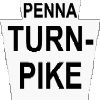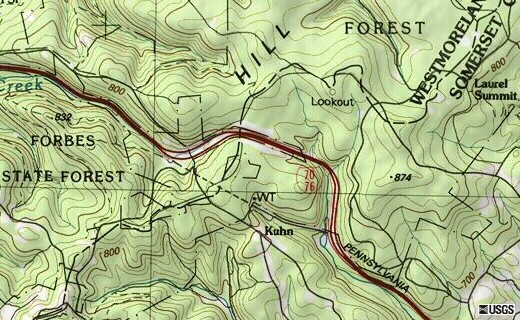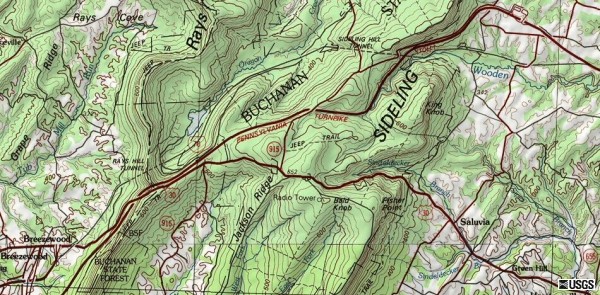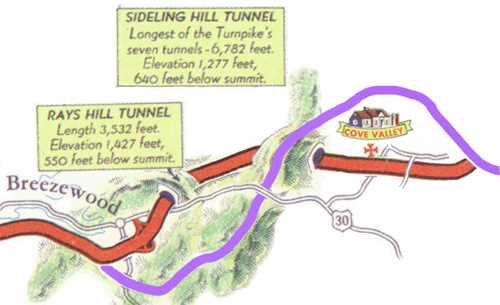 |
This photograph
shows the beginning of the abandoned
section of the Turnpike, facing east. Ahead is the original 1940
alignment. The original
Breezewood interchange was located here.
The access highway to Breezewood veers left,
leaves the
old alignment, and stops at US 30. (Bernie Newman) |
 |
Looking east from the US 30 bridge.
In the center of the picture, the new alignment
of the Turnpike can be
seen at the Rays Hill cut. (Mike Natale) |
 |
This view is between the US 30
overpass and Rays Hill Tunnel. (Mike Natale) |
 |
This picture,
circa 1995, shows the western portal of
Rays Hill Tunnel.
(Mike Natale) |
 |
This picture of the western portal was taken in the
early 1980's. (Mitch Dakelman)
|
 |
Taken in 1973,
a few years after the Turnpike was abandoned. By comparing this with
the previous two pictures, you can readily see the deterioration of the portal
over the years. (Mitch Dakelman) |
 |
Looking out of the eastern portal
of Rays Hill Tunnel. (Mike Natale) |
 |
Just beyond Rays Hill
Tunnel. (Mike Natale) |
 |
Between Rays Hill Tunnel and
the Oregon Road overpass. (Mike Natale) |
 |
Looking toward
the Oregon Road overpass.
The farthest point of highway visible here
is almost two miles
away. (Mike Natale) |
 |
Looking east with Sideling Hill
Tunnel just visible in the background. The trees in the
median have since
been removed. (Mike Natale) |
 |
The western portal of Sideling
Hill Tunnel. (Mike Natale) |
 |
Looking east out of the western
portal of Sideling Hill Tunnel. (Mike Natale) |
 |
The location of the
former Cove Valley Service Plaza is visible to the left.
Although the building was
torn down, the parking lot remains. (Mike Natale) |
 |
Looking east from the
overpass. The jointure of the highway and the new Turnpike is
located just out of view in this picture. (Mike Natale) |
 |
The old alignment
converging with
the new alignment is visible in the background in this view taken at the
eastern end of the tour. (Mike Natale) |
 |
Looking west
toward the
overpass. (Mike Natale) |
 |
From atop the
overpass, looking west. The basketball hoop and picnic table belong
to a home, which is out of view to the left in this photo. (Mike
Natale) |
 |
Looking west at Cove Valley Service
Plaza. (Mike Natale) |
 |
West of Cove Valley, approaching
the eastern portal of Sideling Hill Tunnel.
(Mike Natale) |
 |
The eastern portal of Sideling
Hill Tunnel. (Mike Natale) |
 |
Taken inside the western
end of Sideling Hill Tunnel, looking west. (Mike Natale) |
 |
Immediately outside the Sideling
Hill Tunnel looking westward. (Mike Natale) |
 |
Looking west between the tunnels,
with the Oregon Road overpass in the
foreground. (Mike Natale) |
 |
The eastern portal of
Rays Hill Tunnel is shown in this photo. At 3,500 feet in length, it
was the shortest tunnel on the
Turnpike and only needed ventilation fans at the western end. This
picture was
taken in the early 1980's, when two of the letters ("RA") spelling out the
tunnel name were still attached. (Joey Koldys) |
 |
Looking west, just west of Rays
Hill Tunnel. An underpass for a local highway is in
the foreground. In the early
90's, the PTC repaved one lane here to test out rumble
strip patterns (SNAP-Sonic Nap Alert Pattern). The
new guardrail on the right side
also dates from that era. (Mike Natale)
|
 |
This picture, taken just before
the US 30 overpass, shows the Breezewood end
visible in the
background. (Mike Natale)
|
 |
Back to the beginning of the tour, with the
Breezewood access highway in the
background. (Mike Natale)
|
 |
Looking eastbound behind the Ramada in Breezewood,
which is the start of the
Super Highway Trail. (Jeff Kitsko)
|
 |
Facing the current exit, which was the original
Turnpike. Traffic is waiting to enter
US 30 to continue onto the section of Interstate 70 that comes up from the
Maryland
border. A direct connection is impossible and unlikely to be
built. (Jeff Kitsko)
|
 |
Farther away from the western end atop the US 30
overpass. (Jeff Kitsko)
|
 |
Looking westbound on US 30 towards
Breezewood. (Jeff Kitsko)
|
 |
Western portal of the Rays Hill Tunnel. (Jeff
Kitsko)
|
 |
The eastern ventilation room-less portal of the
Rays Hill Tunnel. (Jeff Kitsko)
|
 |
The Turnpike east of Rays Hills facing
eastbound. (Jeff Kitsko)
|
 |
The right-of-way between the two hills and those
tunnels, which bear their names,
just
south of Valley Lake. (Jeff Kitsko)
|
 |
In the early years, tunnel lighting was provided by
these recessed fixtures. They
were harder to maintain than the current fluorescent lighting used today.
(Jeff Kitsko)
|
 |
View of the Turnpike from the Sideling Hill Tunnel
maintenance building.
(Jeff Kitsko)
|
 |
View of the old ventilation fans still residing in
the western portal of the Sideling Hill
Tunnel. (Jeff Kitsko)
|
 |
Eastern portal of the Sideling Hill Tunnel.
(Jeff Kitsko)
|
 |
Looking westbound from the location of the former
Cove Valley Service Plaza.
(Jeff Kitsko)
|
 |
Communications tower which is located at the
Sideling Hill Service Plaza, the
replacement for Cove Valley, which shows how close they are to each other.
(Jeff Kitsko)
|
 |
The area where the group of trees are is where the
Cove Valley plaza building once
stood. (Jeff Kitsko)
|
 |
Former location of the gas pump islands, which sat
on the western side of the
plaza. The lines on the pavement are not original, but were painted by the
Pennsylvania State Police when they used this area as a gun range. (Jeff Kitsko)
|
 |
Looking eastbound from Cove Valley towards the
point where the two alignments rejoin, with Scrub Ridge in the background.
(Jeff Kitsko)
|




